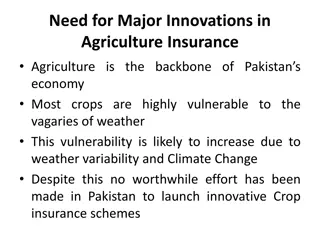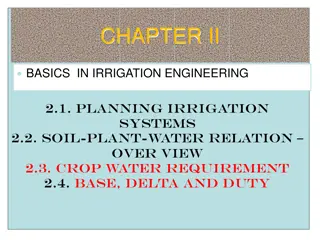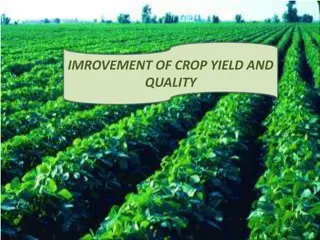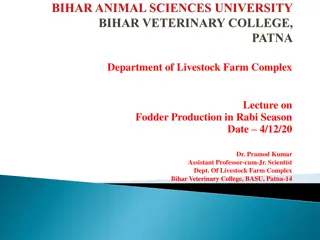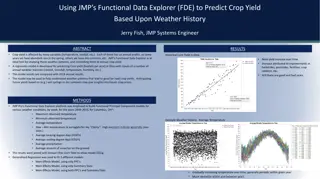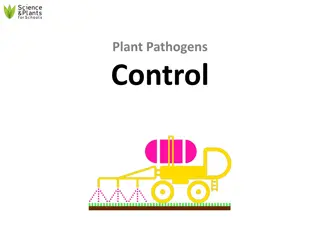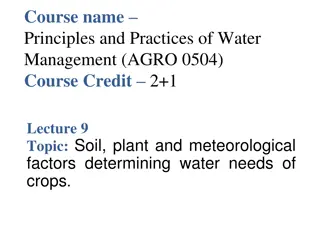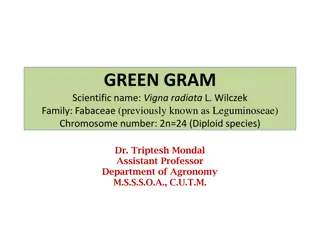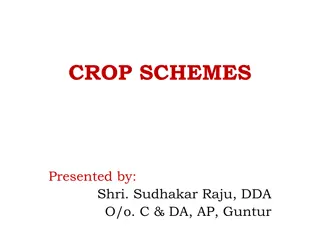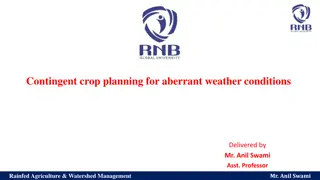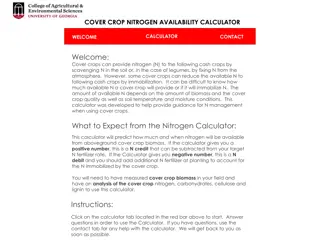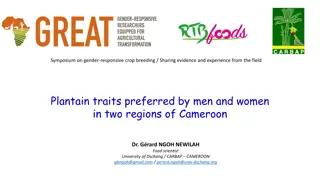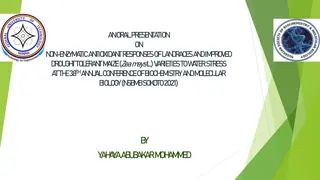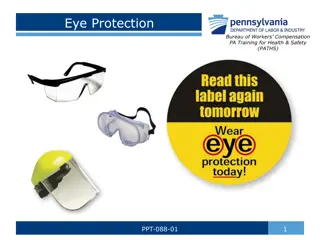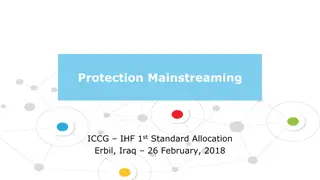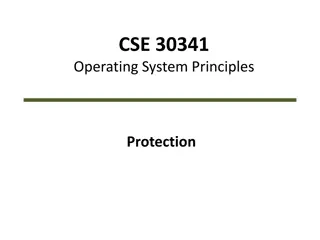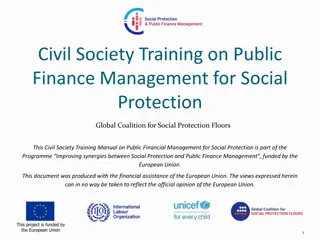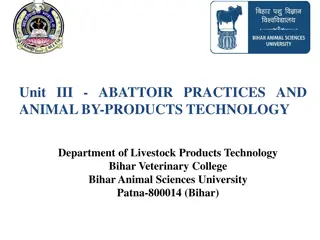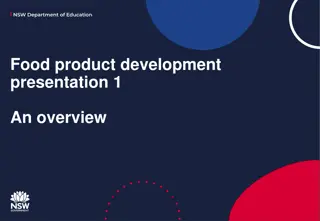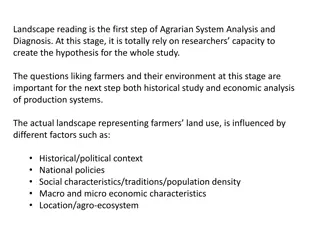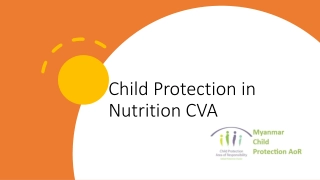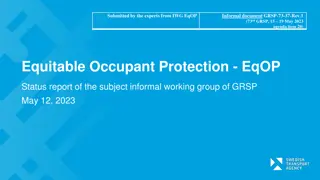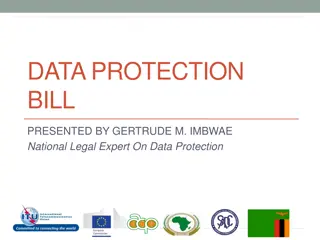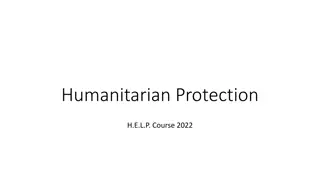New Crop Protection Products: BioSafe Systems OxiDate 5.0 and ANEEM
BioSafe Systems, a family-owned manufacturer based in East Hartford, CT, introduces innovative crop protection products OxiDate 5.0 and ANEEM for organic and conventional agriculture. OxiDate 5.0 is a broad-spectrum liquid plant bactericide/fungicide with active ingredients Hydrogen Peroxide and Peroxyacetic Acid. It is EPA registered and effective against major foliar diseases on various crops. The product's mode of action involves oxidation of bacterial and fungal cells/spores. Application rates and schedules are provided for preventative, curative, and rescue treatments. BioSafe Systems focuses on providing biodegradable and reduced-risk solutions for crop protection.
Download Presentation

Please find below an Image/Link to download the presentation.
The content on the website is provided AS IS for your information and personal use only. It may not be sold, licensed, or shared on other websites without obtaining consent from the author. Download presentation by click this link. If you encounter any issues during the download, it is possible that the publisher has removed the file from their server.
E N D
Presentation Transcript
Crop Protection Product Update(s) BioSafe Systems Industry Food Use Product Updates Session IR 4 Food Use/Integrated Solutions Workshop Sept. 23, 2019 Patrick L. Clark Technical Sales Representative BioSafe Systems LLC
A family-owned manufacturer of biodegradable and reduced risk crop protection products. Headquartered in East Hartford, CT, USA Biochemical (Peracetic Acid Based), Botanical and Microbial based Biopesticides for organic and conventional Agriculture, Horticulture and Ornamental markets. Products registered in US, Canada and Mexico.
New Crop Protection Products from BioSafe Systems OxiDate 5.0 ANEEM PyClear
OxiDate 5.0 Active Ingredients: Hydrogen Peroxide: 27.0% Peroxyacetic Acid: 5.0% Add text 1 Add text 2 Add text 3 Add text 1 Add text 2 Add text 3 Add text 1 Add text 2 Add text 3 US EPA Registered Broad Spectrum Liquid Plant Bactericide/Fungicide Labeled for control of major foliar diseases on wide variety of crops including but not limited to Fruiting Vegetables, Cole crops, Cucurbit crops, Leafy Vegetables, Tree crops, Berries, Citrus crops, Grapes, Pome Fruits, Tree nuts and other permanent crops EPA Registration No. 70299-28 Registration Pending in CA
OxiDate 5.0 Mode of Action Product Features Formulation Type: Soluble Liquid (SL) Non-residual, exempt from pesticide tolerances Excellent addition to rotations for resistance management Safely integrates with other chemical and biological disease management programs in Pome fruits REI-1 hr in enclosed environments; Wait until sprays have dried. In combination with H202, PAA is a strong anti-microbial. Works by oxidizing Bacterial/Fungal cells/spores with which they come into contact. Damage to cellular macromolecules including lipids, proteins and nucleic acids occur upon oxidation.
OxiDate 5.0 Preventative Application Rates: Begin applications early in season. Use a rate of 1:800-1:500 (16-26 fl. oz. of OxiDate 5.0 per every 100 gallons of water). Maintain a 5-10 day spray schedule to prevent the establishment of disease inoculum Curative Application Rates: For best results, apply at first sign of disease. Use a 1:256 dilution rate (50 fl. oz. of OxiDate 5.0 per every 100 gallons of clean water). Maintain a 3-10-day spray schedule until control is achieved. Rescue Treatment Rates: (For use on: Bulb Vegetables, Cereal Grains & Commodities, Cotton, Cranberries, Cucurbit Crops, Fruiting Vegetables, Legumes, Peanuts, Root & Tuber Vegetables). Concentrations up to 1:100 (1 gallon of OxiDate 5.0 for every 100 gallons of water) can be used as a rescue treatment for severe infestations. Maintain a 3-5 day spray schedule until control is achieved.
OxiDate 5.0 2020 IR-4 Biopesticide Study Request(s) -Request for product consideration on any of the following pest(s) or crop(s) as prioritized by IR-4 to develop additional data to support registration efforts with EPA and California. -Fire Blight (Apples) -Black Rot (Xanthomonas)-Brassica -Botrytis/Bacterial Spot/Speck/Canker (Tomato) -Spotted Wing Drosophila (All Crops) -Downy Mildew (Basil) -Powdery Mildew and Black Rot (Grapes) -Bacterial Leaf Spot/Angular Leaf Spot (Cucurbit and Pepper)
ANEEM Active Ingredient(s): Cold Pressed Neem Oil ..70.0%* Azadirachtin 0.7% Formulation Type: Emulsifiable Concentrate (EC) Expected EPA registration: Summer, 2020 Proposed label for use on wide variety of vegetables, fruits and ornamentals (outdoors or in greenhouses) for control of important insect pests, mites, nematodes and foliar fungal diseases including Powdery Mildew Proposed application Rates: 0.5%-1.5% v/v solutions (0.5%, 1.0% and 1.5% v/v) Can be sprayed up to and including day of harvest (0 PHI) Thorough coverage of upper and lower leaf surfaces is essential for good control
ANEEM Mode of Action As an Insecticide/Miticide ANEEM controls target pests on contact or by ingestion. The Neem Oil in ANEEM coats insect's body, blocks the respiratory openings resulting in insect suffocation and death. The product also acts on target insects and mites by way of repellence, anti-feedant action and interference with the molting process. As a Fungicide Neem Oil in ANEEM is know to prevent germination and penetration of fungal spores resulting in prevention or control of certain foliar fungal infections.
ANEEM Kale-Whiteflies (BioSafe Systems, 2019) 25 19.5 20 a 17.7 16 14.8 #? WhiteFly?Adults/Leaf 14.5 15 13.3 b b b b 10 8.6 8.1 6.5 6.5 5 0 Untreated ANEEM? 0.5% ANEEM? 1% ANEEM? 2% CHEN? 2%? * Pre-Treatment 1? Day? After? Treatment % are given in v/v * CHEN = Clarified Hydrophobic Extract of Neem Oil (70%)
ANEEM Citrus-Red Mites (BioSafe Systems, 2019) 20 17.5 a 14.1 #? Red? Mites? per? Leaf 13.8 15 12.3 12 8.8 10 b b b b 5 2.6 1 0.8 0.7 0 Untreated ANEEM? 0.5% ANEEM? 1% ANEEM? 1.5% ANEEM? 2% Pre-Treatment 5? Days? After? Treatment % are given in v/v
ANEEM 2020 IR-4 Biopesticide Study Request(s) -Study requests on any of the following pest(s) or crop(s) as prioritized by IR-4, to develop additional data for supporting registration efforts with EPA and in California. -Potato Leaf Hopper (Potato) -Downy Mildew, Organic Basil -Chilli Thrips (All Crops) -SWD -Varroa Mite (Honey Bee) -BMSB and White Fly (Q-Biotype)-All crops -Bagrada Bug and Cabbage Looper (Brassica) -Apple Maggot and Codling Moth-Apple -Squash Bugs (Cucurbits) -Asian Ambrosia Beetle (Avocado) -ACP (Citrus) -Berry Borer (Coffee) -Cabbage Aphid (Brassicas) -Striped Cucumber Beetle (Cucurbits, Vegetables) -Colorado Potato Beetle (Potato)
PyClear Plant Insecticide Active Ingredients: Pyrethrins ..3.0% Piperonyl Butoxide 30.0% Formulation Type: Emulsifiable Concentrate (EC) EPA Reg. No.: 89459-40-70299 Expected launch by BioSafe Systems in Spring, 2020 Not registered in California Not for Organic Use
PyClear Labeled for use as an Insecticide on vegetables, fruits and ornamentals (outdoors or in greenhouses) Application Rate: 0.75 to 2.5 fl.oz per 10 gallons of water Can be sprayed up to and including day of harvest (0 PHI) Thorough coverage of upper and lower leaf surfaces is essential for good control Mode of Action Pyrethrins in PyClear are neurotoxic that moves systemically in the insect body. Targets primarily the insect neuron system by binding of the voltage-gated sodium channel resulting in quick knock down of the target insect through loss of coordination and paralysis. Piperonyl Butoxide acts as a synergist increasing the toxicity of Pyrethrins.
PyClear Labeled for use to control wide variety of insect pests of following crops: VEGETABLES: beets, carrots, horseradish, potatoes, radishes, celery, lettuce, parsley, spinach, broccoli, cabbages, cauliflowers, beans, peas, cucumbers, melons, pumpkins, summer squash, watermelons, zucchini. FRUITS: grapefruits, lemons, limes, tangerines, oranges, apples, pears, apricots, cherries, nectarines, peaches, plums, grapes, raspberries, blackberries, strawberries. HERBS AND SPICES: anise (aniseed), balm, basil, borage, burmet, camomile, caraway, catnip, chicory, chives, clary, coriander, costmary, cumin, curry leaf, dill, fennel (Italian and sweet), fenugreek, horehound, hyssop, marigold, marjoram-sweet (oregano), marjoram (wild), mint, nasturtium, paprika, parsley, pennyroyal, rosemary, rue, sage, savory (summer and winter), sweet bay (bay leaf), tansy, tarragon, thyme, wintergreen, woodruff, wormwood. ORNAMENTALS: African violet, ageratum, aster, azalea, begonia, cactus, calceolaria, calendula, calla, camellia, carnation, ceanothus, chrysanthemum, cineraria, coleus, cyclamen, cypress, daffodil, dahlia, delphinium, eucalyptus, fern, ficus, foliage plants, fuschia, gardenia, geranium, gladiolus, gloxina, gypsophila, hyacinth, hydrangea, feles, iris, ivy, lily, maidenhair fern, marigold, narcissus, orchid, pansy, pelargonium, peony, petunia, philodendron, phlox, poinsettia, pyracantha, rhododendron, rose, rubber plant, snapdragon, stock, sweet pea, tulip, viburnum, wandering jew, zinnia and Andromeda, arbovitae, ash, beech, birch, boxwood, butternut, chamaecyparis, cherry, cotoneaster, crabapple, dogwood, Douglas fir, elm, euonymus, fir, firethorn, forsythia, hackberry, hawthorn, hemlock, hickory, holly, honey locust, horse chestnut, juniper, larch, laurel, lilac, linden, London plane, magnolia, maple, mimosa (silk tree), mountain ash, myrtle, oak, pachysandra, peach, pine, planetree, poplar, privet, quince, spruce, sycamore, Taxus, tulip tree, walnut, willow, yew.
PyClear 2020 IR-4 Insect Efficacy Study Request(s) -Study requests to develop and support additional data at lower than current labeled rate and to support registration efforts in California. -Potato Leaf Hopper (Potato) -BMSB, SWD and White Fly (Q-Biotype)-All crops -Chilli Thrips (All Crops) -Apple Maggot and Codling Moth-Apple -Varroa Mite (Honey Bee) -Asian Ambrosia Beetle (Avocado) -Bagrada Bug and Cabbage Looper (Brassica) -ACP (Citrus) -Corn Root Worm (Corn) -Berry Borer (Coffee) -Squash Bugs (Cucurbits) -Cabbage Aphid (Brassicas) -Flea Beetles (Eggplant) -Striped Cucumber Beetle (Cucurbits, Vegetables) -Pepper Weevil (GH Pepper) -Colorado Potato Beetle (Potato) -Wireworms (Potato)
Thank You From BioSafe Systems, LLC Patrick L. Clark pclark@biosafesystems.com 609-668-8488 www.biosafesystems.com Toll Free: 1-888-273-3088



